Intel's new Atom Microarchitecture: The Tremont Core in Lakefield
by Dr. Ian Cutress on October 24, 2019 1:30 PM EST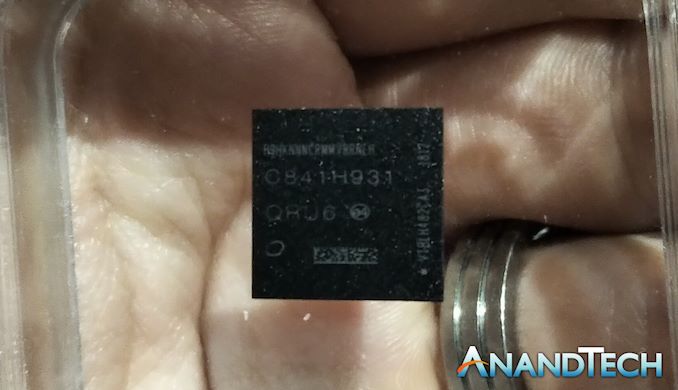
While Intel has been discussing a lot about its mainstream Core microarchitecture, it can become easy to forget that its lower power Atom designs are still prevalent in many commercial verticals. Last year at Intel’s Architecture Summit, the company unveiled an extended roadmap showing the next three generations of Atom following Goldmont Plus: Tremont, Gracemont, and ‘Future Mont’. Tremont is set to be launched this year, coming first in a low powered hybrid x86 design called Lakefield for notebooks, and using a new stacking technology called Foveros built on 10+ nm. At the Linley Processor Conference today, Intel unveiled more about the microarchitecture behind Tremont.
For the sake of clarity, a pre-note on ‘Core’ vs ‘core’:
- ‘Core’ and ‘Atom’ are Intel’s two main x86 microarchitecture families
- A ‘core’ is a single designated CPU capable of processing instructions, and can be built by Intel with either ‘Core’ or ‘Atom’ microarchitectures
A Brief History of Atom
Intel’s lower powered Atom microarchitecture has been used for a variety of solutions: embedded platforms, networking, smartphones, tablets, netbooks, NAS devices, control hubs, and a wide array of things we don’t even know about. The positioning of Atom compared to Core was meant to be that Atom was the smaller core design, taking up less silicon die area and being lower performance, but ultimately lower power in a time where the Core microarchitecture was focused more towards high performance designs.
The last few generations of Atom are readily quantified: Silvermont based on 22nm was a big product for the company, which has evolved into Airmont, Goldmont, Goldmont Plus, and now Tremont.
| Intel's Atom History | ||||||
| AnandTech | Node | Smartphone | Tablet | Netbook Notebook |
Networking Server |
|
| Saltwell | 32nm | 2011 | Medfield Clover Trail+ |
Clover Trail | Cedar Trail | |
| Silvermont | 22nm | 2013 | Merrifield Moorefield |
Bay Trail-T | Bay Trail-M Bay Trail-D |
Rangeley Avoton |
| Airmont | 14nm | 2015 | 'Riverton' | Cherry Trail-T | Braswell | Denverton |
| Goldmont | 14nm | 2016 | 'Broxton' | Willow Trail Apollo Lake |
Apollo Lake | |
| Goldmont+ | 14nm | 2017 | Gemini Lake | |||
| Tremont | 10+ | 2019 | Lakefield | Lakefield | Snow Ridge | |
The Atom family lines get a little confusing with Intel playing in all these spaces. The Atom core within in given family is usually identical (L2 configuration might change), and because of the SoC in play, it might get a different name based on the market where it was headed. Intel scrapped the smartphone program back with Broxton in 2016, and the tablet type of SoC has also gone away. With Lakefield, combining Core and Atom, it could be used in Tablets again for 2019/2020, but we will see it in Notebooks with the Surface Pro Neo and in networking/embedded markets as Snow Ridge.
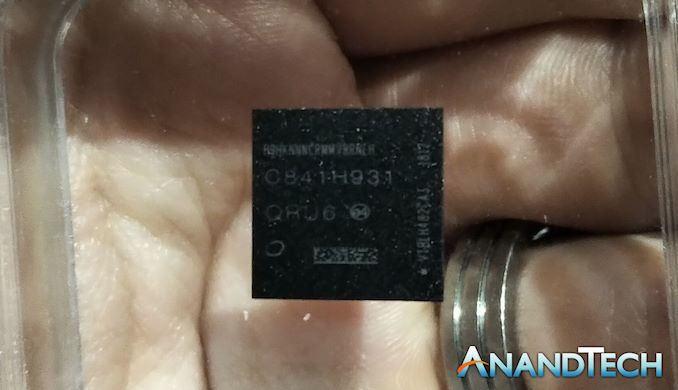
Lakefield - 12mm x 12mm, 2mW Standby Power
It is worth noting that as Intel expanded the scope of its Core microarchitecture, from 1.5W per core to 20W+ per core, it has kind of edged Atom more into niche products. Atom still had that super-low-power advantage, with a much smaller die area, but has also been super low performance with a quantifiable step-function below what Core can provide. With Tremont, Intel’s primary focus was bringing the single thread performance of the Atom design in parity to Core at the lower end of performance, with a sizeable overlap between the performance of a single Core design against a single Atom design. Intel published this graph to demonstrate what this looks like on early silicon:
Now, Intel’s Atom platforms haven’t had the greatest press over the last few years. Aside from providing some really nice notebooks around the $200 range on the consumer side, the enterprise side has been dealing with a clock degradation issue that ultimately leaves Atom systems built on C2000 processors unable to boot, which was bad news for embedded Atom systems designed to run for 10-20 years. Intel has since fixed that bug with a silicon update, but the point of that silicon was for it not to be touched for a generation.
With that aside, Intel is looking to revive its Atom fortunes with the new Tremont design, and looking forward to Gracemont and beyond. More performance, crossing over with Core, and with hardware built on Intel’s latest 10+ process, should afford a number of opportunities. Until we get our hands on the hardware, we’re going to examine the design.
Design Goals for Tremont
The odd quirk about CPU design is that for engineers that have been embedded in this space for 20 years, when they were taught about processor design, the main focus was all about performance. Little attention was paid to power. Fast forward to today, and power is the often talked about point when it comes to battery powered devices, and learning to design for both performance and power becomes an intense balancing act for all the engineers involved. We’ve spoken to companies that only allow performance enhancements if the power increase is at most equal in percentage, or perhaps a 2:1 ratio of performance/power. It’s a difficult pie to bake at any rate.
The interesting thing here in our briefing with Intel is that they specifically stated that Tremont was built with performance in mind, and the aim was for a sizeable uptick in the raw clock-for-clock throughput compared to the previous generation Atom, Goldmont Plus. Based on Intel’s own metrics, namely using SPEC, Intel is going to claim an average 30% iso-frequency performance uplift in core performance for Tremont over Goldmont Plus.
It’s worth noting here that this data is from an early Tremont design we were told, and should represent minimum uplifts. The graph is somewhat skewed at the top end with three of the SPEC tests getting 65%+ uplifts, and at the time of discussion, Intel did not have to hand exactly which tests these were (likely libquantum, lbm). We weren’t told how the code was compiled, however Intel did state that the same compiled binaries were used on both Tremont and Goldmont Plus. Intel didn’t state if they’re actually adjusting the clock of each core to match each other, or doing a performance per clock analysis using the frequency as a division factor. These results have to be taken at face value.
A 30% average jump in performance is a sizeable jump for any generation-to-generation cadence. Just taking it as-is feels premature: aside from microarchitectural advancements and a jump to 10nm, there has to be something at play here – either the power budget of Atom has ballooned, or the die area. With Intel explicitly out of the gate stating that their focusing on performance, a cynic is going to suggested that something else has paid that price, and to that end Intel wasn’t prepared to talk about power windows or die area, though they did point to the already announced Lakefield CPU, which has a 1 x Core + 4 x Tremont design and gets compared to 7 W CPUs.
Comparing 14nm Goldmont Plus (that’s standard 14nm, not 14+ or 14++) to a 10+ Tremont core is going to be difficult: the Tremont core has more in it to drive that performance, however what is not known is how much space was saved moving from 14nm to 10+ and if the extra parts make the core bigger or smaller overall. Needless to say, Tremont has more in it to drive that performance, which we’ll cover in the next few pages.


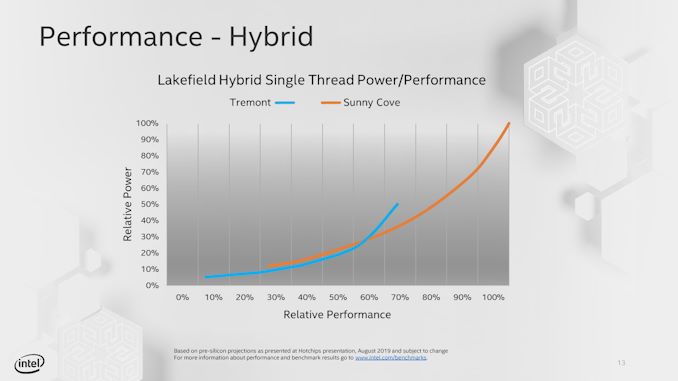
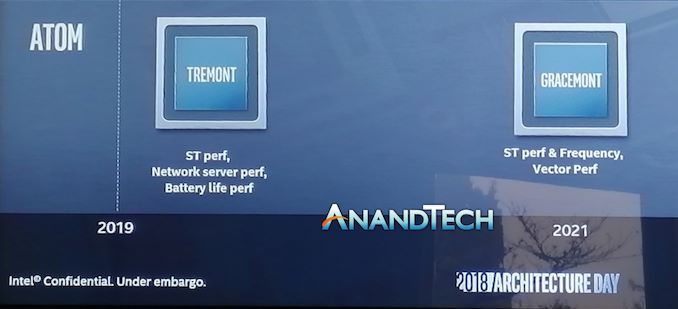
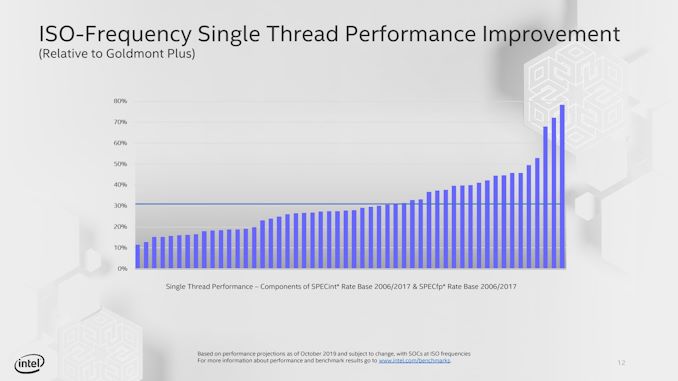
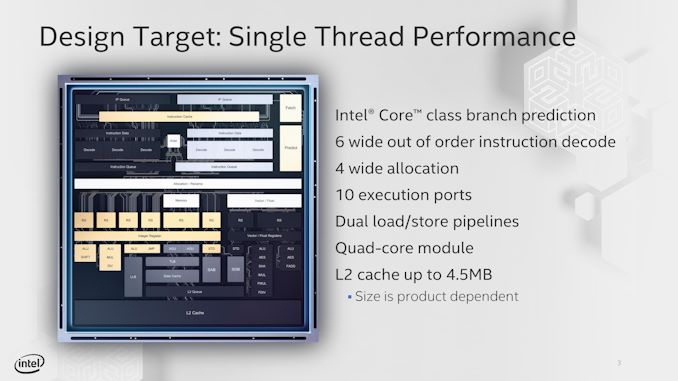








101 Comments
View All Comments
Namisecond - Friday, November 1, 2019 - link
Which will be far more important for devices that run Windows.petr.koc - Friday, October 25, 2019 - link
"the enterprise side has been dealing with a clock degradation issue that ultimately leaves Atom systems built on C2000 processors unable to boot,"This is unfortunately not precise as all Atom Bay Trail processors (desktop, mobile, server) including 14nm successors manufactured up to approximately 2018 are affected with LPC circuitry degradation issue that will kill them in the end:
https://en.wikipedia.org/wiki/Silvermont#Erratum
https://en.wikipedia.org/wiki/Goldmont#Erratum
29a - Friday, October 25, 2019 - link
Ugh, I just look at your links and I have a NAS box with a J1900. I wonder what can be done to replace it?MASSAMKULABOX - Thursday, October 31, 2019 - link
Yeah, I'm amazed this didnt byte Intel in the Ass much harder, AFAIK synology and cisco were both victims and I'm sure many others. So, start by making well-tested, reliable products.. and no harm in boosting up the GFX side of things (x2 X3?). Give us desktop systems @10w and lowerBigos - Friday, October 25, 2019 - link
> (We therefore assume that a 3.0 MB L2 will be 15-way.)That is very unlikely. 3.0MB (which is 3 * 1024 * 1024) is not divisible by 15. I'm sure the 3MB L2$ will be 12-way associative.
1.5MB = 12 * 128kB
3.0MB = 12 * 256kB
4.5MB = 18 * 256kB
AntonErtl - Friday, October 25, 2019 - link
It's clear that they drop products with low-$/area when they do not have enough capacity, but AFAIK that's not the case at the moment for 10nm; on the contrary, they have 10nm capacity and not much demand for Ice Lake (because they cannot get the clock rates and efficiency competetive with the 14nm Skylake derivatives). So building Tremont-based successors for Gemini Lake (where performance is not as critical) would be a way for them to get more revenue out of their 10nm production line(s?); of course they have to design that first, and they may have failed to do so, expecting Ice Lake production to be in full swing by now.Concerning sucking performance, here are some numbers for our LaTeX benchmark http://www.complang.tuwien.ac.at/franz/latex-bench...
2.368 Intel Atom 330, 1.6GHz, 512K L2 Zotac ION A
1.052 Celeron J1900 (Silvermont) 2416MHz (Shuttle XS35V4)
0.712 Celeron J3455 (Goldmont) 2300MHz, ASRock J3455-ITX
0.540 Celeron J4105 (Goldmont+) 2500MHz
0.200 Core i7-6700K (Skylake), 4200MHz
Skylake has about a factor 1.6 better IPC than Goldmont+, and allows higher clock rates (at higher power consumption), resulting in significantly better overall performance, but whether that makes the Goldmont+ suck depends on the application.
29a - Friday, October 25, 2019 - link
Decoding video, that's what the other two Atoms I've owned sucked at.PeachNCream - Friday, October 25, 2019 - link
You keep thrashing at that, but other people that have dissimilar experiences have supported claims that run contrary to your statements. What model Atoms and under what conditions haev you had this problem? This isn't an issue for anyone else and, frankly, watching video isn't the only thing a computer does so that complaint may have no impact on the wider range of use cases beyond watching YouTube and Netflix.Jorgp2 - Friday, October 25, 2019 - link
He probably has an in order atom.Pretty much all out of order atoms have hardware decoding acceleration
GreenReaper - Saturday, October 26, 2019 - link
Or, he's trying to decode a video that isn't supported by the hardware. Like 10-bit anything until very recent. In fairness my Bobcat cores struggle with 60FPS anything, and plain Full HD MP4 decode also bogs down if you add anything but the most minimal of shader filters. But they're from ~2011.